Growing Summer Squash Vertically
This post may contain affiliate links, which means that I may receive a commission if you make a purchase using these links. As an Amazon Associate I earn from qualifying purchases.
Summer squash are among the easiest and most productive plants to grow in the garden. They are fun to grow too since there are so many different shapes, colors, and varieties. Often times I find myself trying to squeeze in more varieties than I have room for in the garden.
Summer squash loves the summer heat, and usually begins producing within 60 days after planting and continues all season until frost, disease, or squash vine borer takes it out.
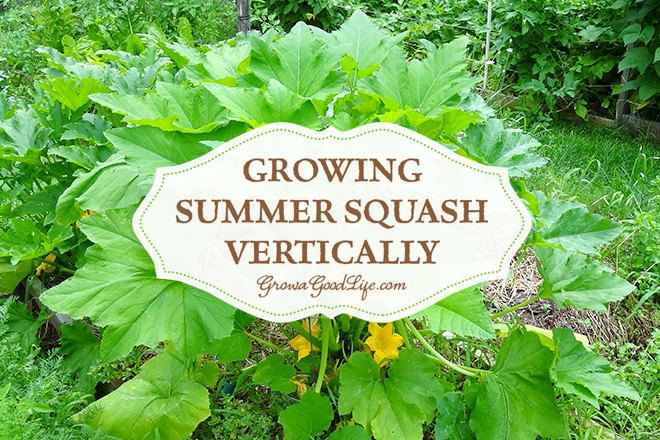
What is Summer Squash?
Squash is divided into two types, winter squash and summer squash. Summer squash differs from winter squash in that it is harvested young while it is still tender.
There are so many varieties of summer squash, including zucchini or courgette, patty pan or scallop, yellow crookneck, and yellow straight neck squash. Each type has many varieties, colors and shapes.

In contrast, winter squash has a thicker rind and is harvested in the fall, cured, stored, and consumed during the winter months. Common winter squash varieties include acorn, butternut, pumpkin, and spaghetti squash. Winter squash usually grows on long, rambling vines.
Most summer squash have a bushy growth habit. The fruit begins forming at the base of the stem and continues developing up the stalk as the plant grows. Even though summer squash plants are bush like, the stem of the plant does tend to lengthen a little as it grows.
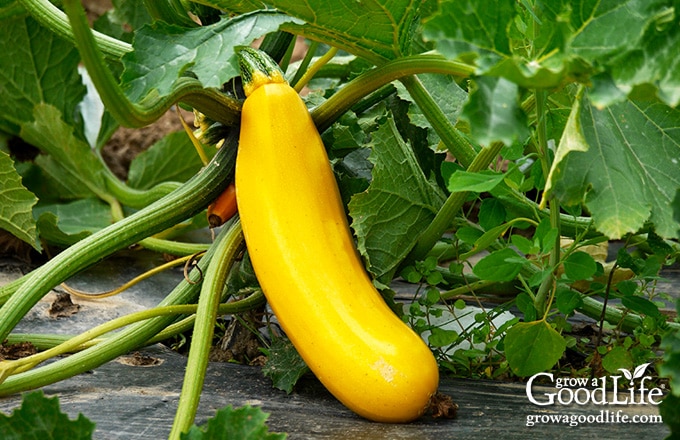
Since I have been converting my garden to permanent raised beds that are only 3-feet wide, I had to think of some creative ways to keep the summer squash confined to the bed and prevent it from flopping out into the aisles. For me, the logical answer was to grow summer squash vertically using tomato cages to support the plant and keep it upright.
Benefits of Growing Summer Squash and Zucchini Vertically
Although the reason I wanted to grow summer squash upright was to save space, I quickly discovered that growing summer squash and zucchini in tomato cages had other benefits as well.
- Growing summer squash vertically saves space. The plants can easily be trained to remain in the tomato cage as it grows. The cage provides support and keeps the plant upright, preventing it from flopping out of the growing bed into the walking paths.
- Growing zucchini upright encourages air movement. Good air circulation around the plant helps the foliage stay dry and averts downy mildew and other fungal diseases.
- Vertical growth keeps the squash off the ground. There is less chance of the fruit rotting from excess moisture since the squash is not touching the ground.
- It’s easier to see the zucchini to harvest. Growing upright allows the squash to be more visible reducing the chance of overgrowth. No more giant zucchinis!
- More light gets to the plant when growing upright. Zucchini and summer squash thrive in sun. Since the foliage is more spread out when growing upright, there is less shading allowing the plant to absorb more sunlight. Also, most pollinators prefer to forage in sun.
- Less places for squash bugs and other pests to hide. Squash bugs, cucumber beetles and other pests have less area to hide near the ground. Also, since the foliage is upright, it is easier to scout for and destroy eggs before they hatch.
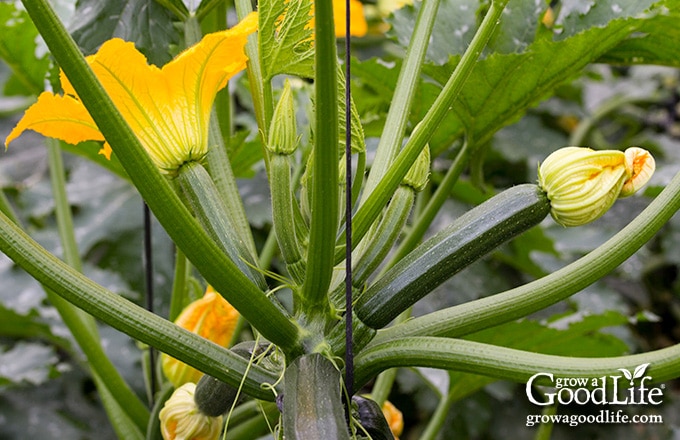
How to Grow Zucchini in Tomato Cage
Step 1: Plant the zucchini and summer squash. Either transplant seedlings or direct sow summer squash in a mound of soil.
Step 2: Add the tomato cage. Simply place a tomato cage securely in the ground when the zucchini and summer squash are young. Push the legs into the ground up to the first ring.
If you are using a flimsy tomato cage, hammer in a stake or long piece of rebar for extra support. Tie the tomato cage securely to the stake.
Step 3: Mulch the plants. Add organic mulch around the plants to help keep the weeds down, the roots cool, and conserve moisture. Keep the mulch a few inches away from the stem of the plant.
Step 4: Guide the zucchini and summer squash up. As the plant grows, gently direct the foliage and stem upward through the tomato cage. A few of the hollow stems do bend over the cage wires as the plant grows, but overall the benefits of growing summer squash vertically outweigh a few bent stems.
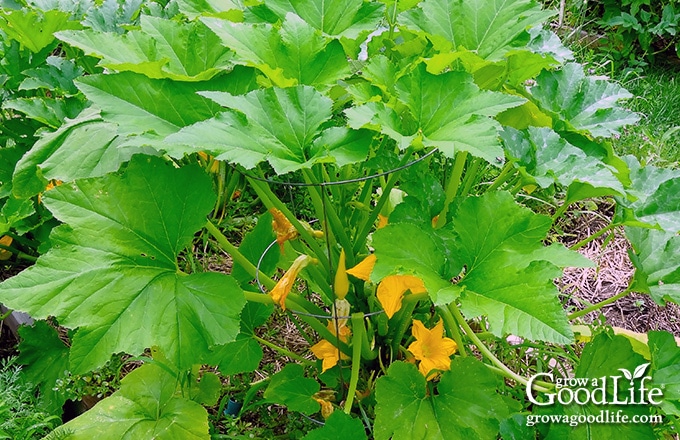
Growing summer squash vertically by trellising or in tomato cages helps to save space, encourages air circulation, and allows the squash to be more visible reducing the chance of overgrowth.
You May Also Like:
- 3 Easy Ways to Preserve Summer Squash
- Zucchini Garlic Bites Recipe
- DIY Self-Watering Containers
- How to Build a Square Food Garden
Good planning is key to a successful vegetable garden
Whether you are new to growing your own food or have been growing a vegetable garden for years, you will benefit from some planning each year. You will find everything you need to organize and plan your vegetable garden in my PDF eBook, Grow a Good Life Guide to Planning Your Vegetable Garden.
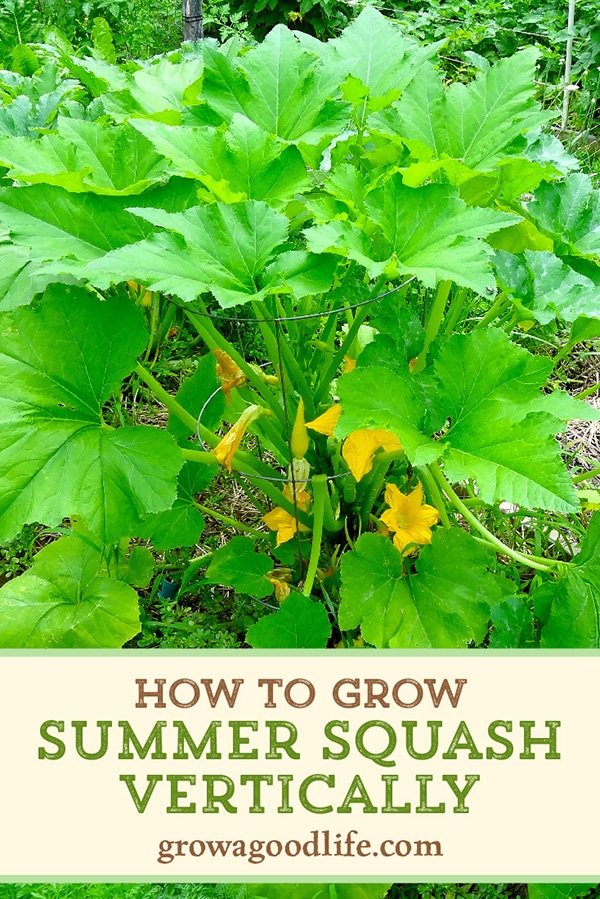


Growing a zucchini in a tomato cage is hardly “growing summer squash vertically”. Which runs smack-dab into a pet peeve of mine: why are there so few vining summer squash varieties? I did a brief stint of gardening a couple decades ago. I remember a vining zucchini that had fruit that was almost indistinguishable from a bush-type zucchini. Wish I could remember its name.
At some point someone decided nobody wants or needs vining zucchinis. Can you imagine someone unilaterally deciding pole beans were no longer an option? Needless to say, I don’t get it.
I have a plot in the public garden, across the street. 20’X10′. And I have trellised my front and back balconies, 20′ long on the back and 10′ long on the front. Not a lot of space if I don’t trellis.
The public garden has been running for a few decades now. The cucumber beetles and vine borers have been running wild, with zero control, ever since. On my farthest trellis from these beasties (back balcony), I’ve been able to successfully grow melons and cucumbers (knock wood), to where I basically stop picking fruit because I’m overrun, especially with cucs. I get the occasional cucumber beetle (striped) flying on the plants, but never enough to lose more than a plant or two, if that.
I’ve never grown more than 5-10 cucumbers in the public garden, in any one season. The bugs are that bad. 90 garden plots, full infestation.
I tried Table Dainty, last season. A vining cucumber (marrow) that’s fat like a football (gridiron) when allowed to grow. At any early stage, the zucchini taste is pronounced and delicious. I got one withered zucchini on the vine last season. Couldn’t even eat it.
Long story short, I’ve been scouring the internet, trying to find a vining summer squash with resistance to vine borers and cucumber beetles. I’ve come up with a list, of sorts, in descending order of seeds I’ve just bought, and in the order I plan to plant them in future gardens:
Tatume: A round squash, best picked at baseball size for summer squash eating. Doubles as winter squash. Have read it’s resistant to pests. We’ll see.
Yuxi Jiang Bing Gua: Distorted Pumpkin shape. Also doubles as summer and winter squash, 3-8 lbs respectively. Huge sprawling vines. Cucurbita Moschata.
Lemon Squash: Puts out dozens of large lemon-sized summer squashes. Very popular and prolific.
Zucchino Rampicante: I grew this squash 5 years ago. Wowed everyone with 4 foot “snakes” with big heads at one end. Summer and winter squash. Cucurbit Moschata.
Table Dainty: I’ve grown this one the most. It seemed fairly impervious to pests, until a couple of seasons ago. Now I get one fruit or none. Period. One of the best vining zucchinis I’ve ever eaten. Grow it, if your pest situation will tolerate it. Highly recommended.
If anyone knows of any other varieties of vining summer squash, please make a list and tell me.
Thanks
Eugene, It is true. Most summer squash has been developed to grow bushy plants or short vines that rarely grow more than 4-feet long. Which is why a large tomato cage is sufficient for growing summer squash vertically.
I too have searched over the years for summer squash varieties that would grow longer vines that could be tied up a tall trellis structure and haven’t found much. The only vining summer squash I have tried are Zucchetta Rampicante (AKA Tromboncino) and Italian Cucuzzi Summer Squash (which is actually a type of gourd). They didn’t produce very well in my garden. Hopefully, others will read your comment and chime in with their experiences.
What kind of mulch? Is that hay around squash in picture? If hay is good – Is ALFALFA hay ok to use? TY!
Jan, Alfalfa hay is fine as long as it was cut before it forms seeds. Otherwise the seeds will sprout in your garden. If you click on the green organic mulch link in, Step 3: Mulch the plants, it will bring you to another article that goes into more detail on how organic mulch helps your garden, and type of organic mulch you can use.
how many seeds do plant in one hill of zucc. thank you sue snead
Sue, if you are growing summer squash vertically using a stake or tomato cage, just grow one plant. There is only room for one plant to grow in a tomato cage. If you are planting zucchini in hills and letting the vines sprawl, a 2-foot mound can support 3 plants. Sow about 5 or 6 seeds per mound, and thin down to the strongest 3.
Or you could simply grow a bush type of zucchini. No vining so no trellising is necessary
Shelley, Even bush varieties can grow 3 to 4 feet vines. Using a trellis will help keep the plants upright instead of spreading out.
The easiest way to reduce problems from SVB (Squash Vine Borers) is to plant resistant varieties of squash. While no squash is totally immune, varieties that have thicker or tougher stems are less susceptible. That includes most winter squash, or summer varieties like Tromboncino or tatume.
Great tips, Steve! Thanks for sharing.
You are an inspiration to me and I am trying this for the first time. But need help …it seems every time I trim leaves I loose blossoms or they just close up and die. Any thoughts?
Eva, blossoms only open for a day or so. If your blossoms are not getting pollinated, the will shrivel up and die. Here is an article that explains how to hand pollinate that may help: How to Hand Pollinate Squash
Thanks for this information. I attempted to grow my squash vertically last year but I think I waited too late to corral the into the cages. My question: Should those hollow stems that escape the cage be cut off or does it make any difference?
Nan, If the hollow stems bend over the cage like shown in the picture, they will die eventually. I usually let them die naturally because it gives the plant time to heal where the stem connects to the stalk. Cutting them off when they are still green may make the plant vulnerable to pests and diseases.
Hi! Trimming leaves directly to the main the stem actually encourages additional growth of summer squash and often yields 2 or 3 times more! I do this to save space and encourage growth
Mau, Actually, this is not true. I understand it is a current trend to tie your zucchini and summer squash to a tall pole and trim off all the branches, but this has not been proven to increase yields. In fact, it may even stress your plant, which will reduce yield. A plant’s foliage is necessary for photosynthesis, a process of converting the energy from sunlight and turning it into food needed for growth. In addition, cutting the foliage off leaves an open wound that is vulnerable to organisms and bacteria. The foliage also shades the fruit from the direct sun, protecting the squash from sun-scald. I do not recommend cutting healthy squash leaves off the plant. Leaves that have died naturally can be removed, because the plant has had time to heal the area where the stem connects to the stalk.
Since the flowering occurs where the stem keeps growing, I’ve been trimming all leaves BELOW where the flowers appear — not only does it keep my garden neater, it makes it easier to find and eradicate those pesky squash vine borers. Doing this the last few years has not affected my harvest at all (I get more than enough to eat, freeze, and make our favorite Zucchini Chocolate Cake. Also, why have energy go to those leaves (they are usually the first to die anyway on a plant) when you want the energy in your plant to go towards new growth, flowers and fruit. All that being said, I have never put my squash in a tomato cage or trellised it although I think this year may be the year to try…
You’ve saved me a real headache with this post. I wanted to grow vertically but thought I couldn’t use bush type squash.. Now I have a new use for some very EXPENSIVE, large tomato cages which I never use because I trellis my tomatoes now. So, I might get some squash this year as the cages will keep the plant off of the ground; thank you so much! 🙂
If I use tomato cages how close together can they be? Trying to figure out how many I can fit in a 4×8 raised bed.
Kathleen, I space zucchini and summer squash about 2 feet apart when growing them vertically in tomato cages. So you could fit 8 plants in your 4 x 8 raised bed.
Question
As an organic gardener, how do i keep Suash beetles off my squash and cukes?
Robin, That is a tough one that I don’t have a complete solution for. I fight with squash bugs every year. Squash bugs overwinter in the soil, so plant squash, cucumbers, and melons in a different area each year to avoid early infestation. Row covers can prevent the beetles from flying in and landing on your plants. Crush the eggs on the underside of the leaves, and pick the adult beetles off the plants and drop them into a container of soapy water. Other than that, your best method of protection is to grow healthy plants so they produce before the squash bugs kill them.
Do marigolds help keep squash bugs away?
Debbie, It isn’t scientifically proven, but some gardeners swear that marigolds deter squash bugs. They certainly couldn’t hurt.
The best way to control squash bugs from destroying your plants is to prevent an early infestation. Squash bugs can hide in your soil over winter and re-emerge as soon as the weather warms up. They begin laying eggs right away and these hatch in only a few weeks.
Clean up the garden in fall to remove hiding spaces. Rotate your crops and plant squash in a garden area where no members of the squash family grew last year. You could also day planting squash until after the squash bugs emerge and leave to seek food elsewhere.
Try wrapping aluminum foil around the stem of the vines where they would originally bore in.
I find that if I put wood ashes with crushed eggshells around the squash stems it prevents the borers from laying eggs near the stems so hatched borers don’t bore in.
Billie, This is a great tip! Thanks for sharing.
I love this! My son and I built a bamboo trellis for my winter and summer squash. They are doing great but I may have been careless in my placement of them. There are a bush scallop squash, an acorn squash , 2 zucchini and a orange patty pan squash. There are also 3 marigolds and a few violas.
I will not save seeds this year. I’m not sure what will grow. A winter squash or summer squash? I will be more careful next year.
Thank you for posting this! Brightest blessings.